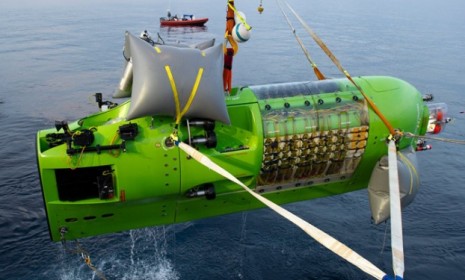James Cameron's 'eerie' deepest-sea odyssey
The Academy Award-winning director made an unprecedented voyage to the deepest point under the sea. What did he find?

Filmmaker and explorer James Cameron, 57, has pulled off a feat never before accomplished: He traveled solo to the Earth's deepest point, the Challenger Deep in the Mariana Trench. How did the Avatar and Titanic director get there, and what did he find? Here, a brief guide to his "eery" voyage:
How far down did Cameron go?
He traveled 35,756 feet, or nearly seven miles, under the sea. At that depth, the water pressure is so great that Cameron's 12-ton, lime-green sub — a "vertical torpedo" called the Deepsea Challenger — actually shrank by 2.5 inches. It took him two hours, 36 minutes to get there from the surface of the western Pacific Ocean, about 200 miles from Guam. He spent three hours on the bottom, then made a relatively quick ascent, hitting the surface in 70 minutes.
The Week
Escape your echo chamber. Get the facts behind the news, plus analysis from multiple perspectives.

Sign up for The Week's Free Newsletters
From our morning news briefing to a weekly Good News Newsletter, get the best of The Week delivered directly to your inbox.
From our morning news briefing to a weekly Good News Newsletter, get the best of The Week delivered directly to your inbox.
What did he find on the bottom?
Not much. "I landed on a very soft, almost gelatinous flat plain," says Cameron. "It was bleak. It was like the moon." If he was expecting to encounter a giant squid or a startling sci-fi monster, he was out of luck. The only creatures the Avatar director spotted were small amphipods, which are common, shrimp-like bottom-feeders. Cameron had intended to explore the ocean's bottom for six hours, collecting samples, but he was forced to come up early with just a tiny cup of sediment.
What went wrong?
Apparently the intense water pressure broke the hydraulic lines used to operate the mechanical arm he needed to pick up samples. That left him unable to do much more than observe. But Cameron promised to return two or three more times once the kinks are worked out, so he can bring back the sediment samples and rocks that his scientific colleagues are hoping to examine. The trench is 120 times larger than the Grand Canyon, and a mile deeper than Mount Everest is tall. "It's time to finally open up this frontier to science," Cameron said.
A free daily email with the biggest news stories of the day – and the best features from TheWeek.com
How did he describe the experience?
As quite humbling. "It's really the sense of isolation, more than anything, realizing how tiny you are down in this big vast black unknown and unexplored space," Cameron said.
So Cameron is the only person who has ever seen this?
Not quite. He's the first person to have made the trip alone. The two-man team of Navy Capt. Don Walsh (now advising Cameron) and the late Swiss engineer Jacques Piccard achieved the feat in 1960, but their Navy submersible, Trieste, was only able to stay down for 20 minutes; they saw little beyond the silt that was stirred up when their bathysphere hit bottom. Cameron got a much longer look, and was able to record the view with onboard cameras. "It's really the first time that human eyes have had an opportunity to gaze upon what is a very alien landscape," says Terry Garcia, the National Geographic Society's executive VP for mission programs. But some day everyone will have a chance: National Geographic, also involved in the project, is making a 3-D movie on the Deepsea Challenger's missions.
Sources: Christian Science Monitor, Guam Guide, National Geographic, USA Today, Washington Post
-
 Farage’s £9m windfall: will it smooth his path to power?
Farage’s £9m windfall: will it smooth his path to power?In Depth The record donation has come amidst rumours of collaboration with the Conservatives and allegations of racism in Farage's school days
-
 The issue dividing Israel: ultra-Orthodox draft dodgers
The issue dividing Israel: ultra-Orthodox draft dodgersIn the Spotlight A new bill has solidified the community’s ‘draft evasion’ stance, with this issue becoming the country’s ‘greatest internal security threat’
-
 Sudoku hard: December 13, 2025
Sudoku hard: December 13, 2025The daily hard sudoku puzzle from The Week